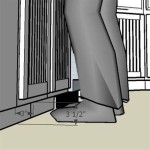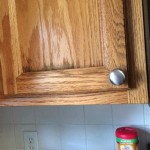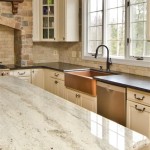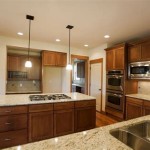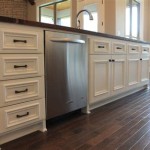Barn House Kitchen Cabinets: Rustic Charm and Modern Functionality
Barn house kitchen cabinets represent a distinctive design trend that blends rustic aesthetics with contemporary needs. These cabinets draw inspiration from the architectural elements and materials found in traditional barns, often incorporating features such as reclaimed wood, distressed finishes, and exposed hardware. The result is a kitchen space that exudes warmth, character, and a connection to the past while providing the functionality and storage solutions expected in modern homes.
The resurgence of barn house design in kitchens reflects a broader cultural appreciation for authenticity, sustainability, and the incorporation of natural elements into interior spaces. As homeowners seek to create environments that are both stylish and comfortable, barn house kitchen cabinets offer a unique way to achieve a welcoming and characterful atmosphere. This article will delve into the key characteristics, design considerations, and practical aspects of barn house kitchen cabinets, providing a comprehensive overview of this increasingly popular cabinetry style.
Key Characteristics of Barn House Kitchen Cabinets
Barn house kitchen cabinets are defined by several distinguishing features that contribute to their rustic and charming appeal. These characteristics often include the use of specific materials, finishes, and hardware selections that evoke the essence of a traditional barn setting.
Material Selection: A primary characteristic of barn house kitchen cabinets is the emphasis on natural and reclaimed materials. Reclaimed wood, often sourced from old barns, factories, or other salvaged structures, is a popular choice for cabinet doors, drawer fronts, and even cabinet frames. The use of reclaimed wood introduces unique textures, grains, and imperfections that tell a story of the material's past life. These imperfections, such as nail holes, knots, and variations in color, are often celebrated as part of the overall aesthetic. Other natural materials frequently incorporated into barn house kitchen cabinets include solid wood species like oak, pine, maple, and hickory. These woods can be selected for their durability, grain patterns, and ability to be stained or painted to achieve the desired rustic look.
Distressed Finishes: To further enhance the rustic aesthetic, barn house kitchen cabinets often feature distressed finishes. Distressing techniques are employed to create the appearance of age and wear, adding character and visual interest to the cabinets. These techniques may include sanding edges to reveal the wood beneath the paint or stain, applying layers of different finishes to create a layered effect, or using specialized tools to create intentional imperfections such as wormholes or dents. Distressed finishes can be applied to both painted and stained cabinets, allowing for a wide range of design possibilities. The level of distressing can also be customized to suit individual preferences, from subtle wear to a more heavily aged and weathered appearance.
Exposed Hardware: Hardware plays a crucial role in the overall look of barn house kitchen cabinets. Exposed hinges, latches, and pulls are common features, contributing to the rustic and industrial-inspired aesthetic. These hardware elements are often crafted from materials like wrought iron, bronze, or brushed nickel, and they may feature a darkened or antiqued finish to enhance their vintage appeal. The hardware is not merely functional; it is also a decorative element that adds visual interest to the cabinets. The size and style of the hardware can vary depending on the overall design theme, ranging from simple and understated to bold and statement-making. The use of exposed hardware allows for a glimpse of the cabinet's construction and adds a sense of authenticity to the design.
Design Considerations for Barn House Kitchen Cabinets
Designing a kitchen with barn house cabinets requires careful consideration of several factors to ensure a cohesive and functional space. The selection of cabinet styles, layouts, and complementary design elements should harmonize with the overall rustic aesthetic.
Cabinet Styles and Layouts: The choice of cabinet styles and layouts can significantly impact the overall look and feel of a barn house kitchen. Shaker-style cabinets, with their simple and clean lines, are a popular choice as they blend well with the rustic aesthetic while also providing a timeless appeal. Slab-front cabinets, particularly when crafted from reclaimed wood, can also be effective in creating a modern and minimalist barn house design. In terms of layout, open shelving is often incorporated into barn house kitchens to showcase dishes, cookware, and decorative items. Open shelving can be constructed from reclaimed wood or metal, further enhancing the rustic charm. Islands are also a common feature in barn house kitchens, providing additional workspace and seating. Kitchen islands can be designed with barn-inspired details, such as shiplap siding, reclaimed wood countertops, or industrial-style legs.
Color Palettes: The color palette for a barn house kitchen should complement the natural materials and rustic finishes. Neutral colors like whites, creams, grays, and beiges are often used as a base, creating a light and airy feel. These neutral tones can be paired with warmer accents, such as browns, tans, and earthy greens, to add depth and character to the space. Pops of color can be introduced through accessories, such as dishware, textiles, and artwork. When selecting paint colors for barn house kitchen cabinets, consider using matte or eggshell finishes to avoid a overly modern or glossy look. Stained cabinets typically showcase the natural wood grain, so the choice of stain should complement the wood species and the overall color scheme.
Countertops and Backsplashes: The selection of countertops and backsplashes should also align with the barn house aesthetic. Natural materials like granite, soapstone, and wood are popular choices for countertops, providing durability and visual appeal. Concrete countertops can also be a good option, offering a modern and industrial-inspired look. For backsplashes, consider using materials like subway tile, brick, or stone to add texture and visual interest. Shiplap backsplashes, replicating the look of barn siding, can also be an effective way to enhance the rustic charm. The color and texture of the countertops and backsplashes should complement the cabinets and create a cohesive and harmonious design.
Practical Considerations for Barn House Kitchen Cabinets
Beyond aesthetics, practical considerations are essential when selecting and installing barn house kitchen cabinets. Factors such as durability, maintenance, and cost should be carefully evaluated to ensure a long-lasting and functional kitchen space.
Durability and Maintenance: Barn house kitchen cabinets, particularly those made from reclaimed wood, may require special attention to durability and maintenance. Reclaimed wood can be more susceptible to moisture and temperature changes than new wood, so it is important to properly seal and finish the cabinets to protect them from damage. Regular cleaning with a soft cloth and mild soap is recommended to maintain the cabinets' appearance. Avoid using harsh chemicals or abrasive cleaners, as these can damage the finish. Distressed finishes can be more forgiving when it comes to scratches and blemishes, as these imperfections often blend in with the existing wear. However, it is still important to take care to avoid excessive damage.
Cost Considerations: The cost of barn house kitchen cabinets can vary depending on factors such as the materials used, the complexity of the design, and the level of customization. Reclaimed wood can be more expensive than new wood due to the labor involved in sourcing, processing, and preparing the material. Custom-built cabinets will also typically be more expensive than stock or semi-custom cabinets. It is important to establish a budget and carefully evaluate the options available to find cabinets that meet your needs and preferences within your price range. Consider exploring options like using a combination of reclaimed wood and new wood, or opting for less elaborate distressing techniques, to help manage costs.
Installation and Hardware: Proper installation is crucial for ensuring the longevity and functionality of barn house kitchen cabinets. It is recommended to hire a professional cabinet installer with experience in working with reclaimed wood and other natural materials. The installer should be able to properly level and secure the cabinets, ensuring that they are aligned and structurally sound. The selection of hardware should also be carefully considered, as it can impact the ease of use and overall appearance of the cabinets. Choose hardware that is durable, functional, and aesthetically consistent with the barn house design theme. Ensure that the hardware is properly installed and that all screws and fasteners are tightened securely.

Kitchen Layout Ideas Barn House

60 Dream Barn Kitchen Designs Digsdigs

Beach Barn House Style Home Tour Cococozy Modern Kitchen Furniture Cabinets Decor Interior

Barn Kitchen

Dark Cobalt Blue Matte Farmhouse Cabinets Rustic Kitchen Cabinet Design

Kitchen Layout Ideas Barn House

30 Farmhouse Kitchen Ideas Rustic Kitchens

30 Welcoming And Beautiful Barn Kitchens Shelterness

Barnhouse Before After Kitchen Renovation I Diy

30 Farmhouse Kitchen Ideas Rustic Kitchens
Related Posts

